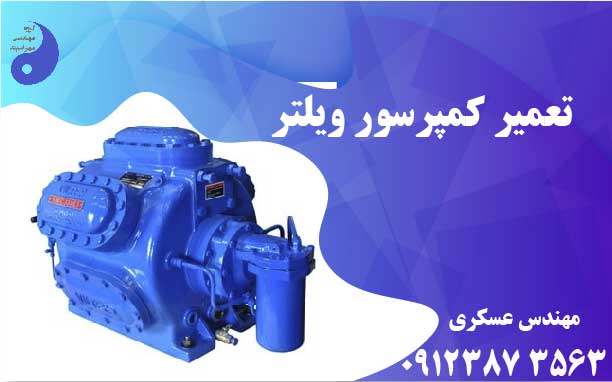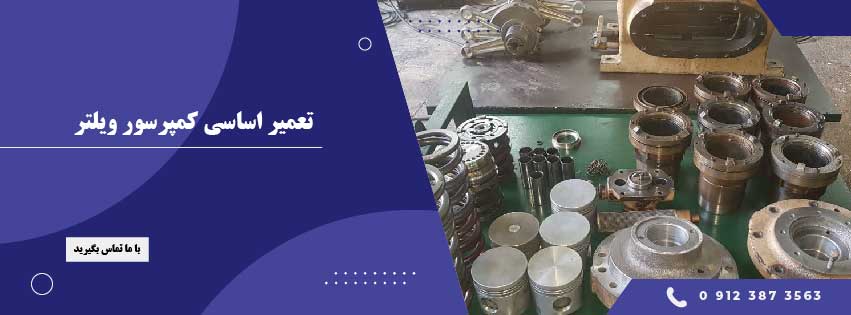تعمیر کمپرسور ویلتر
گروه مهندسی مهراسپند دارای تخصصی ترین کارگاه تعمیرات کمپرسورهای برودتی در ایران است. در کارگاه گروه مهندسی مهراسپند تعمیرات سبک و سنگین و فوق سنگین بر روی کمپرسورهای تبرید انجام می گیرد. بعد از تعمیر کمپرسور ویلتر در محل نصب می شود. و پس از کارکرد تحویل داده می شود و ضمانت کارکرد را داراست.
VILTER MANUFACTURING CORPORATION
VILTER MultiCylinder Compressor
Daily
Clean the suction screen bag. Discontinue use when the bag remains clean. Reserve for system modifications or overhauls.
Weekly
Check system for leaks with a suitable leak
detector for first week of operation.
Check oil levels and oil condition.
Check oil pressures. Determine if oil filter
4.Check refrigerant levels in vessels.
5.Check filters in air handling units.
Check low temperature coils for defrosting.
Check all gauge and temperature readings.
Monthly (Items 1 thru 7 and 8 thru 11)
Lubricate each piece of equipment in ac
cordance with the manufacturer’s instructions. As a general guide, bearings requiring oil should be given attention at least once a month, and those requiring grease at least once every six months
.Check drives for tightness and alignment. Direct drives should have coupling bolts tightened. V-belt drives should have correct tension
Check cooling towers and evaporative
condensers for scaling or algae. Check sprays and screens for clogging. Consult manufacturers of water treatment supplies for corrective measures of scaling and algae problems
Check compressor oil coolers (when used)
for any evidence of corrosion, scaling, or other fouling. See paragraph XI.C for maintenance and servicing
Yearly (Items 1 thru 11 and 12 thru 21)
Check entire system thoroughly for leaks
Drain water from condensers, cooling tow
ers and check tubes. Check carefully for damage by corrosion or scale.
needs changing.
Remove all rust from equipment, clean and
paint.
Check motors and fans for shaft wear and
end play.
Check operation and general condition of
electrical controls.
Check all water strainers.
Check all V-belt drives. Replace worn V
belts and drive components.
CAUTION Replace V-belts in matched sets only.
Check drains to make sure water will flow
away from equipment.
Drain and clean compressor crankcase.
Flush oil circuit. Replace oil filter recharge. Recharge with new, clean, water-free oil.
Check and clean suction strainer
E-System Leaks
variations, the VMC Coming operational
Because of the demanding operational constraints of the VMC Compressor (temperature variations, loosening of joints due to vibration, etc.), the need to periodically test for leaks is a necessity. When any service operation is performed on the system, exercise care to make sure all opened flanges are replaced with a suitable thread filling compound, all packing glands on valve stems are tightened, and all valve caps are replaced. When operation is restored, all joints opened or any valves moved during the servicing should be checked for leaks.
The machine should be pumped down for servicing, the oil taken out and the handhole cover removed. Remove the 14″ (6.35 mm) pipe plug from the top of the seal chamber. Connect the Vilter oil charger to this opening. Pump the flushing solution through the seal chamber and into the crankshaft. Remove each of the pipe plugs in the crankshaft individually and operate the pump until the cleaner is flushed through the hole. Remove the plug, remove the next one and repeat the pumping procedure.
After the plugs are removed and these passages flushed, remove the bearing caps and connecting rods. Examine each of the oil passages to the connecting rods. Inspect the connecting rod bearings.
F-Year-Round Operation
When refrigeration equipment is operated on a continuous year-round basis, a yearly examination of all internal compressor parts is recommended. While the highest material standards are maintained through the Vilter VMC Compressor line, continuous operation and any presence of grime may prove detrimental to the machine. To prevent shutdowns and/or possible breakdowns, your machine should be opened annually. The condition of the internal components should be fully inspected to determine if parts need replacement or repair.
The preceding instructions enable a mechanic/technician to flush the shaft and passages on the 2 through 8 cylinder machines, and the drive end of the 12 and 16 cylinder machines. In order to flush the pump end of the shaft on the 12 and 16 cylinder machines, remove the connection to the center bearing and connect the pump there. Perform the flushing procedures in the same manner for this end of the shaft as for the other end.
G-Flushing The Oil Circuit
After the passages are flushed, open the connection on the bottom of the seal chamber and drain the flushing fluid out. Drain solvent from the crankcase and the interior surfaces of the machine. Replace the pipe fitting in the bottom of the seal chamber and fill the chamber with clean oil. Be sure to pump in enough oil to fill the passages in the crankshaft. Follow the procedure found in Paragraph XVI. Remove the pump and replace the fitting in the top of the seal chamber.
The oil circuit of the Vilter VMC Compressor is protected against dirt, grit, and other foreign material by strainers and filters. Despite the filtering system, microscopic particles of foreign materials are carried through the lubrication system. These materials tend to settle in and clog the oil passages. Vilter recommends the oil circuit in the crankshaft be flushed periodically. It should also be done whenever the machine is opened for repairs. Use mineral spirits or some other suitable refrigerant parts cleaner for flushing purposes. Since the flushing fluid is pumped under pressure, the use of the Vilter oil charger is recommended.
Replace the crankcase cover and charge the machine with clean oil.
H-Crankshaft Seal Oil Leakage


